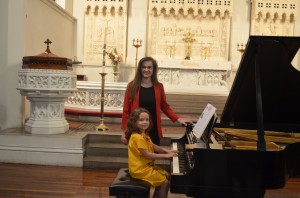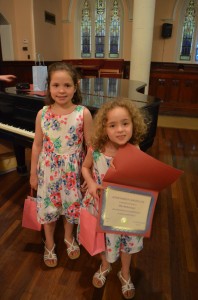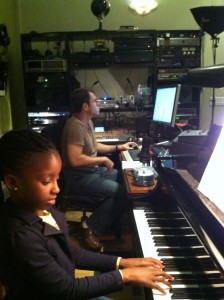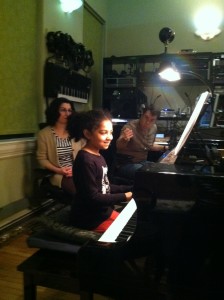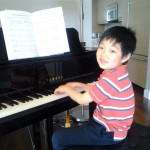Please read this article about us
“Hot Cross Buns”
Three years ago, my daughter started piano lessons as a Kindergartner. Her school offered classes as part of the after-school program. Along with a handful of other children, she spent an hour a week learning the basic concepts of piano playing. I always wished that I had learned to play, but with no musical background or talent, I was thrilled in her interest. We bought an electrical keyboard, and encouraged her to play around with it as much as possible. We must have listened to Hot Cross Buns a thousand times that Fall.
The bond between her and Dina, her instructor, grew throughout the school year and by the time summer rolled around, she wanted to continue. Dina suggested private lessons through Art of Piano Playing Music School, a school she herself had founded a few years ago in New York City– and we excitedly signed on. To say that we got lucky stumbling across Dina and the Art of Piano Playing Music School is an understatement. This amazing organization currently teaches close to 50 private students at various levels, while also working with public schools providing group lessons. There are 20 talented instructors servicing New York City and Long Island.
As I listened in on the lessons at home, I loved seeing and hearing the connection between student, teacher and musical notes. Dina has a true gift in working with children and made it fun for my daughter right from the start. She’s sweet and encouraging and somehow manages to keep the attention of a five-year-old for a full 45 minutes. At that age, it’s no small feat to get through that long without any requests for bathroom or water breaks!
All summer, my daughter looked forward to her lessons and most times, she even practiced on her own. Those first tunes were short and simple but once she mastered them, her pride grew exponentially. Her motivation to learn more challenging pieces grew with time. By the following Fall, Dina encouraged us to invest in a real piano and to start our younger daughter with lessons as well. As luck would have it, a family friend was looking to get rid of their piano, so with some creative reconfiguration of living room furniture, we surprised the girls at Christmas with a tuned piano, adorned with a red bow. Everyone was thrilled – everyone, that is, but our downstairs neighbors!
Steinway Hall
My daughter’s first recital was at Steinway Hall and I remember how excited she was to get all dressed up and show off her hard work. I was amazed that at five-years-old, she and her fellow performers did not seem at all nervous, but instead excited and impatient for their turns. The recital happened to fall on her grandfather’s birthday and she melted his heart by surprising him by playing ‘Happy Birthday’, with her little sister accompanying her on vocals. Afterwards, she glowed while holding bouquets of flowers and happily granting requests for pictures from supportive family members. It was a proud moment for us as parents. For her, it was one of the first instances of the feeling of pride and accomplishment that comes from hard work and determination. It’s a great feeling at any age – and even sweeter when you see your child experience it first-hand.
Last year, when she expressed an interest in composing her own music, Dina not only 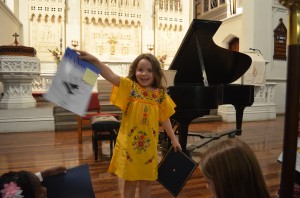 encouraged her, but quickly introduced her to Curt, one of the instructors at her school, who also started composing at a young age. My daughter instantly connected with Curt, who is just as wonderful with children. She jumped right into learning the concepts of composition, eager to create original work. Now, my little one is coming up on completing her first year of lessons and has also fallen in love with the piano.
encouraged her, but quickly introduced her to Curt, one of the instructors at her school, who also started composing at a young age. My daughter instantly connected with Curt, who is just as wonderful with children. She jumped right into learning the concepts of composition, eager to create original work. Now, my little one is coming up on completing her first year of lessons and has also fallen in love with the piano.
It’s so interesting to listen to them during their lessons and see what different learners they are, how they each respond to direction and the different types of pieces they are drawn to. Despite these differences, they are united in their love for this special instrument. Some weeks their lessons are tough. They know very well that if they haven’t put in enough practice time, they will be called on it. It surprises me how readily they accept constructive criticism and how hard they both work to get it right.
Their lessons are typically right after school, at the height of their tired-cranky-hungry state. Miraculously, Dina is able to keep them focused and complaint-free for a solid hour. She’s the perfect mix of seriousness and fun; while strict, there is plenty of praise throughout the lesson and even some giggles. I love listening to her tell my daughters stories about the lives and techniques of the greats like Mozart and Beethoven. Every week, she makes their time together so much more than just about practicing scales and memorizing keys. Once a year, they even have the opportunity to go to a recording studio and make an actual CD of their music. They love feeling like ‘real’ pianists and are always excited to give the gift of their own music to family and friends.
To all teachers..
I’ve read about all the benefits of piano lessons for children and fully believe that, aside from helping children develop a talent and appreciation for music, it also increases their concentration, self-esteem, coordination, critical-thinking , dexterity, and ability to receive and process feedback. This time of year, when most of us are feeling especially thankful for the classroom teachers who have taught our kids the basics and so much more, I’m also so thankful for all the other instructors in their lives; the coaches from a full range of sports teams, the tutors, the art teachers, and all the musical instructors out there. These professionals enable our children to learn new skills, sometimes developing remarkable talents and discovering passions, outside of school, all while becoming well-rounded individuals. For me, teaching my kids to play piano would never be something I could do for them. I am thankful to Dina and Curt for not only teaching my kids this classical art, but also teaching them in a way that has instilled in them, a genuine love and enthusiasm for it.
A few nights ago, we attended our girls’ summer recital. As I sat in the audience listening to students as young as 4 and as old as 50 sit still, focus and proudly play beautiful music, I was in awe. The pieces ranged from the theme of the Flinstones to complicated pieces by Bach. I felt extremely grateful for individuals who have chosen to combine their talent with their profession and share their gift by working with children. As a result, my daughters are learning to play and appreciate beautiful music while gaining skills that will help them long after their lessons may end.
I’m hopeful that with the help of excellent mentors, their passion for the piano will only grow with time and that there will be many more recitals and enthusiastic shouts of ‘Brava’ in their futures.

